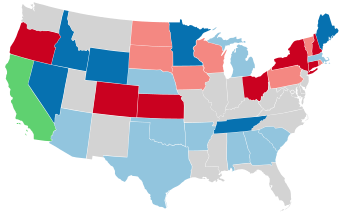
The 1962 United States elections were held on November 6 to elect the members of the 88th United States Congress. The election occurred in the middle of Democratic President John F. Kennedy's term. The Republican Party picked up four seats in the House of Representatives, but the Democrats retained strong majorities in both houses of Congress. In the Senate, Democrats won a net gain of four seats from the Republicans, maintaining control of the Senate. In the gubernatorial elections, neither party won a net gain of seats. Notably, 1960 Republican presidential nominee Richard Nixon lost the California gubernatorial election, which many analysts, as well as Nixon himself, incorrectly predicted to be the end of his political career.

The 2008 United States elections were held on November 4. It was a Democratic wave, Democratic Senator Barack Obama of Illinois won the presidential election, by defeating his challenger, Senator John McCain, by a wide margin, and the Democrats bolstered their majorities in both chambers of Congress.

The 2004 United States elections were held on November 2. Republican President George W. Bush won re-election and Republicans retained control of Congress.

The 2002 United States elections were held on November 5, in the middle of Republican President George W. Bush's first term. Republicans won unified control of Congress. In the gubernatorial elections, Democrats won a net gain of one seat. The elections were held just a little under fourteen months after the September 11 attacks. Thus, the elections were heavily overshadowed by the War on Terror, the impending Iraq War, the early 2000s recession, and the sudden death of Democratic Senator Paul Wellstone of Minnesota about one week before the election.
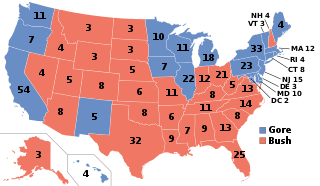
The 2000 United States elections were held on November 7, 2000. Republican Governor George W. Bush of Texas defeated Democratic Vice President Al Gore of Tennessee in the presidential election. Republicans retained control of both houses of Congress, giving the party unified control of Congress and the presidency for the first time since the 1954 elections.

The 1930 United States elections were held on November 4, 1930, in the middle of Republican President Herbert Hoover's term. Taking place shortly after the start of the Great Depression, the Republican Party suffered substantial losses. The election was the last of the Fourth Party System, and marked the first time since 1918 that Democrats controlled either chamber of Congress.

The 1916 United States elections elected the members of the 65th United States Congress. The election occurred during the Fourth Party System, six months before the United States entered World War I. Unlike 1912, the Democrats did not benefit from a split in the Republican Party, but the Democrats still retained the Presidency and the majority in the Senate. Democrats lost the majority in the House, but retained control of the chamber.
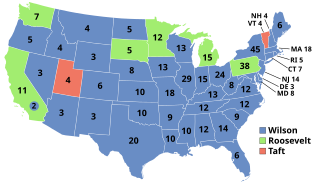
The 1912 United States elections elected the members of the 63rd United States Congress, occurring during the Fourth Party System. Amidst a division between incumbent Republican President William Howard Taft and former Republican President Theodore Roosevelt, the Democratic Party won the Presidency and both chambers of Congress, the first time they accomplished that feat since the 1892 election.

The 1918 United States elections elected the 66th United States Congress, and took place in the middle of Democratic President Woodrow Wilson's second term. The election was held during the Fourth Party System. It was the lone election to take place during America's involvement in World War I. Republicans won control of both chambers of Congress for the first time since the 1908 election.
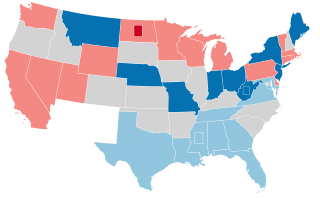
The 1910 United States elections elected the members of the 62nd United States Congress, occurring during the Fourth Party System. The election was held in the middle of Republican President William Howard Taft's term. The Socialist Party won election to Congress for the first time. Arizona and New Mexico were admitted as states during the 62nd Congress.

The 1906 United States elections elected the members of the 60th United States Congress. It occurred in the middle of Republican President Theodore Roosevelt's second term, during the Fourth Party System. Republicans retained control of both houses of Congress.
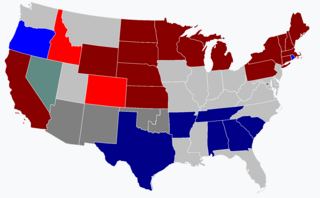
The 1902 United States elections elected the 58th United States Congress, and occurred in the middle of Republican President Theodore Roosevelt's first term, during the Fourth Party System. Roosevelt had become president on September 14, 1901, upon the assassination of his predecessor, William McKinley. Republicans retained a majority in both chambers of Congress, while the Populist Party and Silver Republican Party disappeared from Congress.
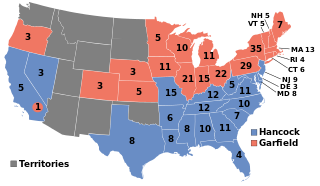
The 1880 United States elections occurred during the Third Party System, and elected the members of the 47th United States Congress. Republicans retained the Presidency and took control of the House. An unclear partisan situation prevailed in the Senate. As the first presidential election after the end of Reconstruction, this election saw the first occurrence of the Democratic Party sweeping the Southern United States; the party would carry an overwhelming majority of Southern states well into the 20th century.

The 1800 United States elections elected the members of the 7th United States Congress. The election took place during the First Party System, and is generally considered the first realigning election in American history. It was the first peaceful transfer of power between parties in American history. The Democratic-Republican Party won control of the Presidency and both houses of Congress for the first time. Conversely, the Federalist Party would never again control the Presidency or either house of Congress. Ohio was admitted as a state during the 7th Congress.

The 1796 United States elections elected the members of the 5th United States Congress. The election took place during the beginning stages of the First Party System, as the Federalist Party and the Democratic-Republican Party clashed over the states' rights, the financial policies of Treasury Secretary Alexander Hamilton, and the recently ratified Jay Treaty. The Federalists maintained control of the Senate, and won control of the House and the presidency.

The 1858 United States elections occurred in the middle of Democratic President James Buchanan's term and marked the end of the transitional period between the Second Party System and the Third Party System. Members of the 36th United States Congress were chosen in this election. In the first election since the Supreme Court decided Dred Scott v. Sandford, the Republican Party won a plurality in the House, taking control of a chamber of Congress for the first time in the party's history. Although Democrats lost control of the House, they retained their majority in the Senate.
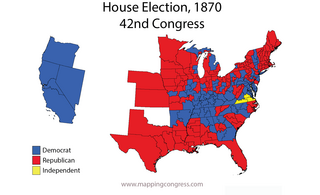
The 1870 United States elections occurred in the middle of Republican President Ulysses S. Grant's first term, during the Third Party System. Members of the 42nd United States Congress were chosen in this election. The election took place during the Reconstruction Era, and many Southerners were barred from voting. It was also the first election after the passage of the 15th Amendment, which prohibits state and federal governments from denying the right to vote on the basis of race, color, or previous condition of servitude, although disenfranchisement would persist. The Republican Party maintained a majority in both houses of Congress, although Democrats picked up several seats in both chambers.

The 1874 United States elections occurred in the middle of Republican President Ulysses S. Grant's second term, during the Third Party System. Members of the 44th United States Congress were chosen in this election. The election took place during the Reconstruction Era, and many Southerners were barred from voting. Colorado joined the union during the 44th Congress. Democrats took control of a chamber of Congress for the first time since the start of the Civil War, winning a huge number of seats from House Republicans. However, the Republicans retained a majority in the Senate. The election marked the first occurrence of the six-year itch phenomenon, in which a president's party lost many Congressional seats during the president's second mid-term election.

The 1878 United States elections occurred in the middle of Republican President Rutherford B. Hayes's term, during the Third Party System. It was the first election following the end of the Reconstruction Era, and Redeemers had gained back control of most Southern governments following the Compromise of 1877. Members of the 46th United States Congress were chosen in this election. Democrats won control of the Senate for the first time since the start of the Civil War. Democrats lost a majority in the House, but retained a plurality and control of the chamber.

The 1882 United States elections occurred in the middle of Republican President Chester A. Arthur's term, during the Third Party System. Arthur had become president on September 19, 1881, upon the death of his predecessor, James Garfield. Members of the 48th United States Congress were chosen in this election. Democrats won control of the House, while Republicans won control of the Senate.

